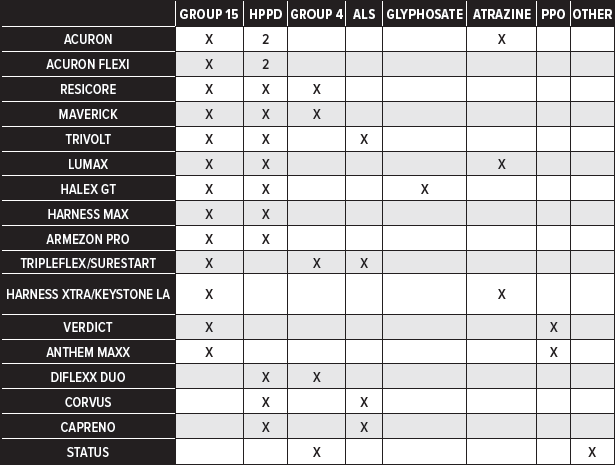

BELOW IS A CHART LISTING OF SOME OF THE PREMIXES WE COMMONLY TALK ABOUT…
Note how many contain a Group 15, and many of those also have an HPPD.
There are obviously some minor differences based on which Group 15 active ingredient (ai) or which HPPD ai is contained in the premix, but this will give you a rough comparison.
When I look at this chart, I mostly get confused.
There are 19 products mentioned here, and this is certainly not a complete list of all the corn premixes you can buy.
How can you possibly decide which herbicide to purchase?
Should you simply rely on your agronomist to make the decision for you or is there a better way to pick your product?
Here are a few simple things we look at on our farm, and maybe this will help you narrow your choices.

1. INVEST THE MOST MONEY IN PRODUCTS THAT ARE BEST ON YOUR TARGET WEEDS
For example, waterhemp is the worst weed on our farm. Stopping waterhemp is our first priority, and grass control is a close number two. Therefore, I want whatever we buy to be great on both.
This is exactly why things get so complicated, because when you look at the eight different chemical families/groups listed in the chart above, every single one of them has activity on either waterhemp, grass, or both. Now, what do we do?
Personally, I like to start with just one weed and pick the best product for that particular weed.
Here are some scenarios to consider.
IF WATERHEMP IS YOUR NUMBER-ONE TARGET:
This eliminates glyphosate and the ALS family due to resistance concerns. The best pre on the list in my opinion is Sharpen (found in Verdict), but I want a full rate of a Group 15 with that, as well, for even better control. Post-emerge, Status is the best, but if an HPPD plus atrazine still works for you, that would be much less expensive.
IF GRASS IS YOUR NUMBER-ONE TARGET:
This eliminates the PPOs, atrazine (yes, atrazine is weak on grass), Group 4’s (dicamba and Stinger), and the HPPDs, as well. A full rate of a Group 15 herbicide is definitely best from a residual standpoint, but post-emerge, glyphosate is hands-down the best choice.
2. ENVIRONMENTAL SAFETY IS OFTEN OVERLOOKED, BUT IT IS ABSOLUTELY CRITICAL.
Atrazine has been found in groundwater far too many times. While it has the same LD50 as table salt, no one wants a pesticide in the water. Most of the atrazine found in groundwater has been traced back to pre-emerge use.
That’s why we NEVER recommend any form of atrazine pre-emerge. Use atrazine post-emerge instead.
Your weed control will likely be even better when sprayed post, and because there will be leaves and roots to absorb the atrazine (not to mention more sunlight, more heat, and usually less rainfall later in the spring), there will be far less chance of atrazine leaching away.
3. RETURN ON INVESTMENT (ROI) SHOULD ALWAYS BE CONSIDERED.
I like products that cost less money. For example, the full rate of a straight mesotrione (the ai found in Callisto) this year is $2 per acre. However, if that doesn’t control my target weeds or if it leads to a carryover issue, my ROI on something else may be much better. For years, we’ve had farmers say Verdict was too expensive compared to SureStart, for example, but if Verdict provides better weed control with less carryover risk, could the ROI be better on your farm even though you invested $3 more per acre?
4. CARRYOVER RISK IS SOMETHING I’VE ALREADY MENTIONED, BUT IT REALLY NEEDS TO STAND OUT ON ITS OWN.
In the last 3.5 years on our farm, we are just over half of normal rainfall. If you are in the same spot we are, carryover should be more of a watchout than ever.
Products that could carryover into soybeans include all the HPPDs, Stinger (Group 4), and atrazine.
On the other hand, we don’t worry about the Group 15’s, Python (found in SureStart & TripleFLEX, Python is labeled for use in soybeans), dicamba, Status, and the PPOs.
5. THE FINAL THING IS WILL MENTION HERE IS TIMING.
Following the label is a must, but common sense should also be used. For example, on the label you cannot spray Verdict after the crop emerges, which is true. On the other hand, DiFlexx and Status are labeled on bigger corn past V5 due to their safeners, but due to dicamba volatility concerns we don’t like to see them sprayed any time other than very early in the season.
While Group 15’s are great and most are labeled in corn up to 11 inches tall, Group 15’s control weeds only through residual activity and contain no burndown characteristics. In other words, using them before weeds have emerged is key.
The timing aspect can make product selection tricky, since none of us know what the weather will do next spring, but plan ahead and talk to your agronomist about when you would like to spray. That is one of the most important decisions when it comes to picking the corn premix for your farm.
